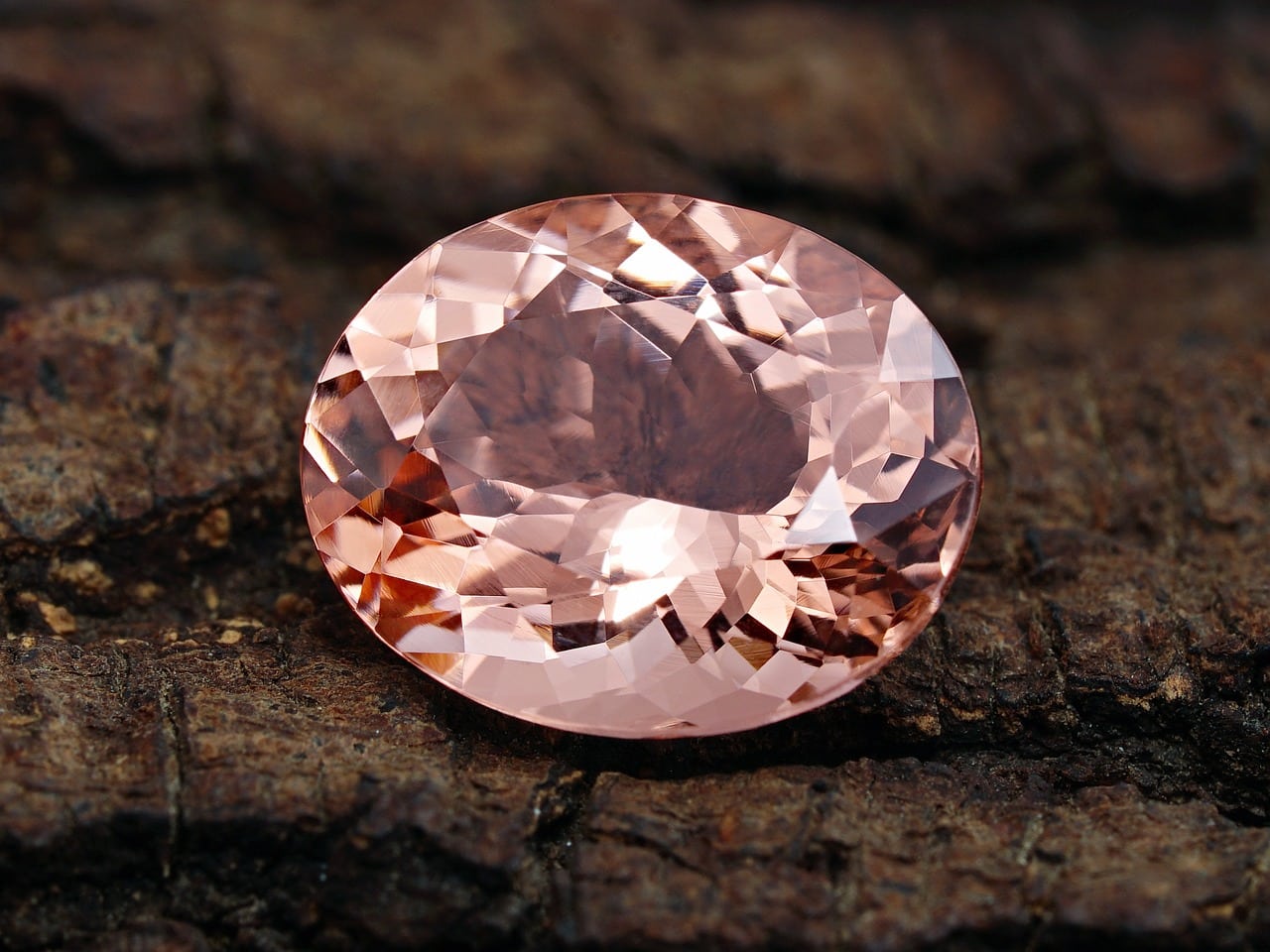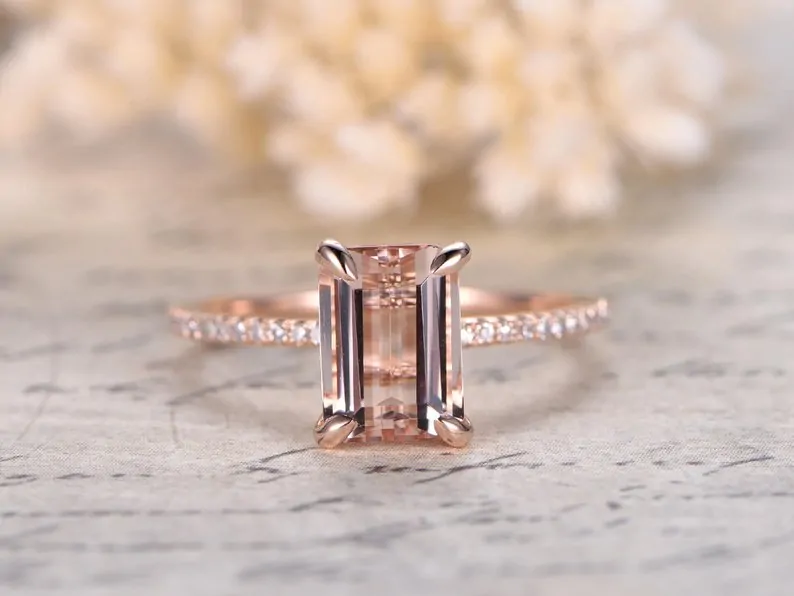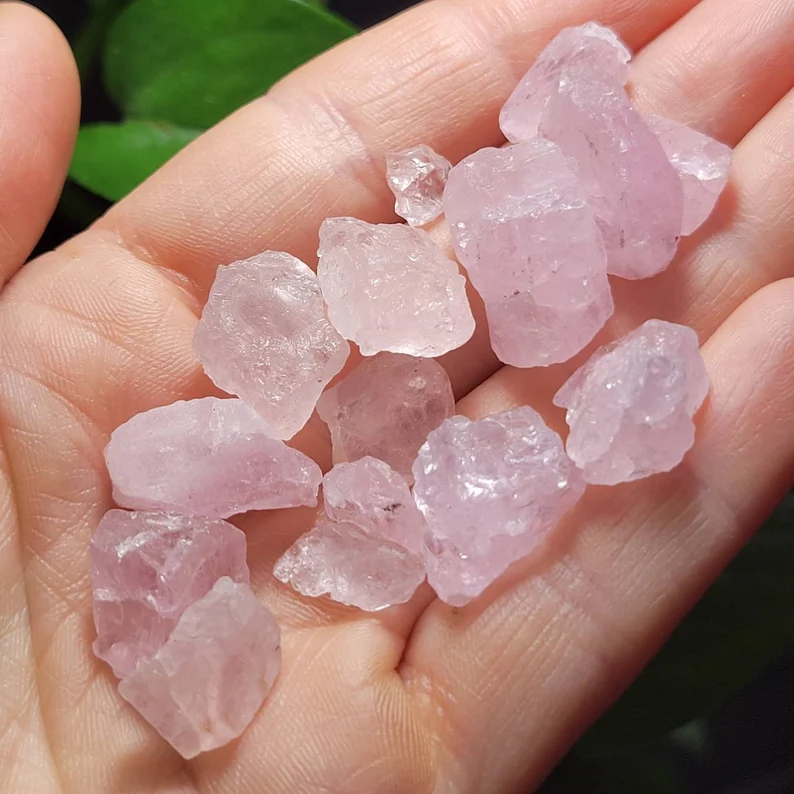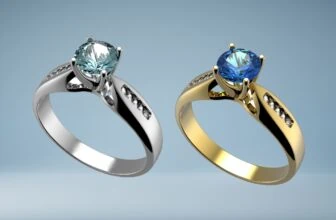
Table of Contents
Morganite is a variety of beryl, the same family of minerals as emerald, aquamarine, and goshenite. It’s ideal in all types of jewelry because of its durability, brilliance, range of pink shades, and relatively budget-friendly price point.
In recent years, it has become one of the most popular gemstones for engagement rings. If you’re looking to buy morganite, there are several quality factors to consider.
1. What Is Morganite Gemstone?

Also called rose beryl, morganite is the salmon-colored variety of the beryl gem family. It gets its pink color from the minerals manganese and/or cesium.
Morganite is durable, with a hardness rating of 7.5 to 8 on the Mohs scale. This makes it sufficiently hard for daily wear and exposure, and a great choice for engagement rings, a piece of jewelry most people wear daily.
2. Where is Morganite Found?
Morganite was first discovered in Madagascar in 1910, where it was initially known as pink beryl. The New York Academy of Sciences later renamed the stone at the suggestion of the chief gemologist of Tiffany & Co. to ‘morganite’ after Tiffany’s avid gem collector, the famous J.P. Morgan.
The gemstone is also found in mineral deposits in Brazil, Mozambique, Namibia, Afghanistan, and Russia.
3. Is Morganite Rare?

Although morganite is much more affordable than its cousin emerald, this doesn’t reflect on its rarity. Morganite is a rare stone, and high-quality morganite can be extremely hard to come across.
However, regardless of this rarity, it remains an affordable gemstone, making it an attractive alternative for more expensive stones such as pink diamonds or pink sapphires.
Some retailers may try to sell morganite under the more attractive name pink emerald. While it’s true that morganite is a variety of beryl and therefore very similar to emerald, this is a misleading way to market the stone. The GIA doesn’t accept this term.
4. How Much Is Morganite Worth?
While prices of any gemstone are determined by the 4Cs and other quality factors, in general, morganite costs around $100 to $300 per carat.
For example, this morganite ring by James Allen, costs less than $1500 with a center stone that’s almost one carat. Compare that to a diamond ring with similar specifications, which could cost closer to $5000, and it’s easy to see why morganite makes for a good choice for engagement rings.
Rich, vivid hued morganite stones are more expensive than paler versions. Also consider that brand names and quality of materials used in the setting also add to the overall price of morganite jewelry.
You’ll find that morganite comes in a variety of prices so it’s important to determine your budget. Once you have decided on how much you can afford to or want to spend, you can stay within those guidelines when shopping.
5. What Are Morganite Quality Factors?
The main quality factors to look out for are the famous 4Cs – color, cut, clarity, and carat.
Morganite Color and Tone

Morganite’s color is feminine, gentle, and elegant. It’s hues usually range from light peach pink to brightly colored salmon, to a heavier violet pink. When assessing the quality of a morganite, color is the most important factor.
Pink and rose tinted morganites are more desirable, while the peach and salmon shades seem less popular.
The saturation of the stone is highly influenced by the amount of mineral inclusion in the crystal. A higher content of manganese or cesium will yield a more saturated pink in the morganite. As a general rule of thumb, the higher the saturation the more valuable the stone.
It’s also important to consider the tone of your morganite gemstone. Tone refers to the lightness or darkness of the stone. For morganites, the variation ranges from almost white to dark pink.
If you’re wondering which is better – there’s no direct answer. It entirely depends on your preference as to which tone to buy.
While light colored morganites can appear more brilliant, even darker shades, though not as lustrous as light colored morganites, reflect light on the surface where the shine compliments the dark interior of the gem.
Morganite Cut

The cut of a morganite is important because it can impact the overall brilliance and value of the stone. Morganite can be cut into different shapes and sizes, with princess, cushion, emerald and round cuts being the most popular.
These stones are typically faceted because they have excellent transparency, allowing them to produce very good brilliance. However, faceting a morganite is difficult as the stone has pleochroism due to the effect of the manganese inclusions. This simply means that it can appear to have different hues based on the angle it is viewed from.
Some of the best cuts for morganite include:
- Princess Cut: The brilliant faceting of this square cut accentuates the sparkle of morganite and can hide any clarity defects the stone may have.
- Emerald Cut: One of the most famous cuts for morganite, emerald cuts are step cuts that have long facets. This accentuates the clarity and clean color of your stone.
- Round Cut: One of the most popular cuts for engagement ring stones, round cuts are also brilliantly faceted and highlight morganite’s sparkle and color.
- Pear Cut: A perfect cut if you want something slightly non-traditional, pear cut morganites are stylish yet traditional.
- Marquise Cut: Similar to the pear cut, but with both ends coming to a point, marquise morganites are eye-catching and stylish.
Morganite Clarity

In the jewelry industry, the clarity of colored gemstones is graded into Type 1, 2 and 3. Morganite is a Type 1 stone, meaning that it is usually eye-clean and without visible flaws.
Morganites with visible inclusions are not often used in jewelry, unless the flaws are expertly hidden by the setting. Look for a clear, lustrous stone that doesn’t contain inclusions.
Morganites with inclusions can sometimes be cut to produce what is known as chatoyancy or a cat’s eye effect. These are best cut en cabochon to accentuate the cat’s eye effect. For this, the stones are polished smooth rather than faceted into geometric, polygonal designs.
Morganite Carat

Carat refers to the weight of any given gemstone. Most commonly, the larger the stone the greater the carat.
However, all gemstones are not created equal, and because some are denser than others, a diamond and a morganite of the same carat weight would most likely be different sizes.
This is why morganites are measured in millimeters rather than carats. You can find morganite in a range of sizes to suit your jewelry needs.
6. Are Morganite Engagement Rings A Good Idea?

As many modern brides opt for non-diamond engagement rings, morganite has become one of the most popular choices. It is similar to more expensive pink gemstones, offering many benefits, but comes at a fraction of the cost. It’s also durable (8 on the Mohs scale) making it perfect for daily wear.
Morganite’s pink tints go exceptionally well with diamonds. This is why you will often find the stone set in a halo design surrounded by little diamonds. Other popular designs are three-stone, solitaire, pave, and split shank.
While prong settings will showcase your morganite to its maximum, exposing the stone on a clawed setting may cause substantial scratching on the edges over time. While six or eight claws would be more secure settings for morganite, consider a bezel setting if security is foremost on your mind.
7. What’s the Best Metal for Morganite Jewelry?

While white and yellow golds go well with morganite, the most popular choice is rose gold. Morganite and rose gold complement each other perfectly, with the transition from stone to metal almost seamless.
The gentle shine of a rose gold band has a less overwhelming effect than gold and is not a hassle when matching outfits.
For morganite jewelry, and especially rings, consider a rose gold basket. A basket is the setting into which the gemstone is placed. It holds the stone in position. If the basket is rose gold in color, it can act as a background for the morganite stone and accentuate its color.
This will make the stone appear more saturated and intense. A bezel setting would also work in this case, but bezel settings can minimize the perceived size of the morganite.
8. How Do You Choose Morganite Jewelry?

Morganite is a neutral color and can accommodate a variety of fashion choices. You don’t have to stress too much about matching it with your outfit as morganite generally complements most other colors.
For a more active lifestyle you can decide on some simple morganite stud earrings or pendant. For a formal event, more elaborate dangle earrings, statement necklace or bracelets will work perfectly.
Smaller elegant pieces of jewelry such as rings are usually set with light colored morganite because the light passing through the crystal produces a star-like luster. For pendants and earrings, choose a heavier shade of pink set on white gold as this allows the stone’s brilliance to pop out.
9. Is Morganite Treated?

To enhance the pink hues of morganite, these stones almost always undergo various heat treatments. This produces a stable color and good saturation. Note that such treatments are standard in the gemstone industry. Heat treatment doesn’t necessarily reduce the value of the stone.
10. Are There Any Morganite Imitations?
While synthetic morganite is rare and hardly exists on the market, you will have to watch out for imitations. Often, glass, peach colored cubic zirconia, or synthetic corundum can be sold as genuine morganite. This is why it is best to shop from trusted and reputable vendors to avoid being conned.
11. How Do You Clean and Care for a Morganite?
Morganite has a hardness ranking of 7.5 to 8, which makes it a durable stone good for daily wear. However, as with any piece of jewelry, it requires regular cleaning to maintain its luster and shine.
Cleaning Morganite
The main concerns when caring for your stone are dust and scratching. To clean your morganite jewelry, follow these simple steps:
- Take a soft toothbrush and mild soap – you don’t need anything fancier than that.
- Next make a warm soapy mixture using clean water and a mild soap.
- Gently scrub your stone clean paying special attention to the stone and the surrounding setting.
- When you feel your stone is adequately clean, use water to rinse it and then dry with a soft cloth.
- For morganites that do not have inclusions or fractures, ultrasonic cleaners or steam cleaners are also safe alternatives.
Storing Morganite
It is also a good idea to store morganite separately, in small boxes or bags individually. As there are other stones and metals that are harder (or softer) than morganite, storing it separately will avoid morganite being scratched by or scratching other jewelry.
For example, diamonds are very hard and can therefore scratch morganites if they aren’t stored carefully, while pears are super soft and can become easily damaged if stored with morganite.
Morganite and Daily wear
While light exposure does not damage morganite and its color, chemicals and heat can. If you choose a morganite engagement ring for everyday wear, you might want to remove the ring when doing household chores where harsh chemicals are involved or physical activities that expose the stone to bumping, dropping and pressure.
12. What is Morganite Meaning and Symbolism?

Morganite is associated with innocence, warmth and love, and is connected to the heart chakra. As the stone opens up the heart chakra, the body is cleansed of anxiety and stress. This gives morganite its nickname – the heart stone.
Morganite is believed to release locked up negative and resentful feelings of fear, unfulfilled emotional needs, and defense mechanisms that stem from insecurity. This allows emotional healing and transformation.
Wearing the stone brings a sense of peace and joy to flow through the body, giving way to acceptance, forgiveness, and growth. Being a symbol of affectionate love, it is also often purchased as a gift for a special someone to deepen a budding relationship.
Whether these beliefs hold any scientific credence or not, they certainly add to the allure of morganite and make them even more desirable.
*Disclaimer: Jewelry Shopping Guide does not guarantee or validate any of the claims related to the metaphysical and alternative healing powers of this or any other gemstone. This information should in no way be used as a substitute for medical advice.
13. Where Should I Buy Morganite Jewelry?
While shopping for morganite jewelry in person allows you to see the stone prior to purchasing it, shopping online offers a range of options and the ease of comparison. As morganite is not as popular as some other gemstones, like diamonds or sapphires, your options may be limited in a brick-and-mortar store.
Shopping for morganite jewelry online can also be more affordable. This allows you to choose a higher quality stone at a budget your comfortable with.
Blue Nile:
If you’re looking for high quality morganite jewelry online, check out Blue Nile. Although their morganite collection is quite limited, what they do offer is expertly crafted and features high-quality morganite gemstones.
Brilliant Earth
Brilliant Earth is popular for their commitment to ethical sourcing. Their pre-made morganite jewelry and options to customize offer plenty of options for every customer. While their jewelry is somewhat pricey, the quality is excellent.
Angara
A well-established online retailer of gemstones, Angara offers a wide range of pre-made morganite jewelry, including the options to customize. You can choose the quality of morganite you’re after, based on your budget. Angara has excellent customer reviews, service, and after-sales policies.
Etsy
Etsy is a must-check, featuring exquisite morganite jewelry, suiting a range of styles, budgets, and purposes from artisans and designers from around the world. You can find everything from antiques to avant-garde designs.
FAQs About Morganite
1. How do you keep morganite sparkling?
To highlight morganite’s brilliance, keep the stone clean. Dirt and grime can dull its sparkle and reduces its refractive index.
2. Does morganite color fade with time?
No, morganite color is stable. It doesn’t fade or discolor over time.
3. Does morganite go cloudy?
If morganite is dirty, it can become dull and cloudy. Carefully cleaning the stone should restore its luster.
4. Does morganite sparkle like a diamond?
Morganite is brilliant but not as much as diamonds. Diamonds are much more brilliant.
5. Does morganite chip easily?
Although it’s a durable stone, morganite can chip or scratch if it’s banged around daily.
6.Is morganite like diamond?
Morganite isn’t like diamonds, as diamonds are harder (10 on the Mohs scale), more brilliant, more well-known, and considered prestigious.
7. Is it normal for morganite to be heat treated?
Yes, most of the morganite on the market is heat treated. This is a normal and accepted method to enhance the stone’s look.
8. Does morganite come in other colors apart from pink shades?
Morganite (or beryl) in other colors is known by different names. For example, clear beryl is goshenite, blue beryl is aquamarine and green beryl is emerald.
9. Can morganite be synthetic?
Yes, there is synthetic (or manmade) morganite, but this is very rare. As natural morganite is somewhat inexpensive, there isn’t much push to make lab created stones.
10. What is the main factor that impacts morganite value?
Color is the most important quality factor and will largely determine the cost of the stone. For example, compare the Good and the Heirloom quality morganites here, and notice how this affects the overall price.
Wrapping Up
Morganite is a stylish, feminine, soft gemstone that’s perfect for all types of jewelry. Because it’s durable, it’s perfect for engagement rings as well and for any jewelry that’s exposed or worn daily. Morganite is also relatively affordable and you can easily find it at most reputable retailers.
Check out this graphic below for a cursory look at what makes morganite so perfect for engagement rings.










